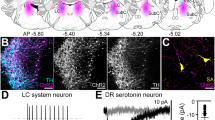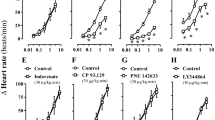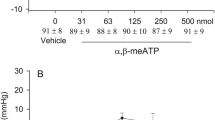Abstract
In addition to its well known actions on postsynaptic adrenoreceptors, noradrenaline released at the sympathetic nerve endings is now believed to modulate subsequent transmitter release through its actions on presynaptic receptors1–7. Much evidence in support of this hypothesis has been obtained from overflow studies in which labelled noradrenaline and metabolites released into the bathing solution are used as an assay of transmitter release. According to Langer4 and Rand, McCulloch and Story6, evidence to favour the existence of such a presynaptic mechanism includes the demonstration that α-adrenoreceptor antagonists produce enhanced transmitter overflow in steady-state conditions of sympathetic stimulation. They also suggest that α-adrenoreceptor-mediated potentiation of transmitter release would not be expected in response to a single pulse, as a threshold concentration of released noradrenaline is required to activate presynaptic inhibition of further release. In the myocardium both conditions have been obtained in the presence of phenoxybenzamine5,6. Surprisingly, although phentolamine is also a potent α-adrenoreceptor antagonist, the potentiation of transmitter release was less than the increase due to phenoxybenzamine6. Studies of transmitter overflow have generally been made with supraphysiological sympathetic stimulation of 5 Hz continuously for 30s or 4 Hz for 60s (refs 6,7). We have used more closely physiological stimulation parameters delivered only during the atrial refractory period. We have now shown that phenoxybenzamine markedly potentiates the chronotropic response to a single pulse and also responses up to maximum stimuli. By contrast, phentolamine and yohimbine were totally without effect even at high concentration. The action of phenoxybenzamine was largely accounted for by its effect on uptake blockade. Taken together, our studies provide evidence against a physiological role of presynaptic α-adrenoreceptors in the heart
This is a preview of subscription content, access via your institution
Access options
Subscribe to this journal
Receive 51 print issues and online access
$199.00 per year
only $3.90 per issue
Buy this article
- Purchase on Springer Link
- Instant access to full article PDF
Prices may be subject to local taxes which are calculated during checkout
Similar content being viewed by others
References
Farnebo, L. O. & Hamberger, B. Br. J. Pharmac. 43, 97–106 (1971).
Enero, M. A., Langer, S. Z., Rothlin, R. P. & Stefano, F. J. E. Br. J. Pharmac. 44, 672–688 (1972).
Starke, K. Naunyn-Schmiedebergs Archs Pharmak. 275, 11–23 (1972).
Langer, S. Z. Br. J. Pharmac. 60, 481–497 (1977).
Rand, M. J., Story, D. F., Allen, G. S., Glover, B. & McCulloch, M. W. in Frontiers in Catecholamine Research (eds Usdin, E. & Synder, S. H.) 579–581 (Pergamon, Oxford, 1973).
Rand, M. J., McCulloch, M. W. & Story, D. F. in Central Action of Drugs in Blood Pressure Regulation (eds Davies, D. S. & Reid, J. L.) 94–132 (Pitman, Tunbridge Wells, 1975).
Langer, S. Z., Adler-Graschinsky, E. & Giorgi, O. Nature 265, 648–650 (1977).
Blinks, J. R. J. Pharmac. exp. Ther. 151, 221–235 (1966).
Paton, D. M. in The Mechanism of Neuronal and Extraneuronal Transport of Calecholamines (ed. Paton, D. M.) 49–66 (Raven, New York, 1976).
Iversen, L. L. The Uptake and Storage of Noradrenaline in Sympathetic Nerves (Cambridge University Press, 1967).
Starke, K., Borowski, E. & Endo, T. Eur. J. Pharmac. 34, 385–388 (1975).
Lockhandwala, M. F. & Buckley, J. P. Eur. J. Pharmac. 40, 183–186 (1976).
Cavero, I. et al. Br. J. Pharmac. 67, 283–292 (1979).
Mouillé, P., Huchet, A-M., Lucet, B., Chelly, J. & Schmitt, H. J. cardiovascular Pharmac. 1, 515–528 (1979).
Docherty, J. P. & McGrath, J. C. Br. J. Pharmac. 66, 55–63 (1979).
Iversen, L. L. Adv. Drug. Res. 2, 5–23 (1965).
Story, D. F., Story, M. E., McCulloch, M. W., Hope, W. & Rand, M. J. Clin. exp. Physiol. Pharmac. 1, 429–439 (1974).
Salt, P. J. Eur. J. Pharmac. 20, 329–340 (1972).
Trendelenberg, U. Trends pharmac. Sci. 1, 4–6 (1979).
Adler-Graschinsky, E. & Langer, S. Z. Br. J. Pharmac. 53, 43–50 (1975).
Author information
Authors and Affiliations
Rights and permissions
About this article
Cite this article
Angus, J., Korner, P. Evidence against presynaptic α-adrenoreceptor modulation of cardiac sympathetic transmission. Nature 286, 288–291 (1980). https://doi.org/10.1038/286288a0
Received:
Accepted:
Issue Date:
DOI: https://doi.org/10.1038/286288a0
This article is cited by
-
Further study of prerequisites for the enhancement by ?-adrenoceptor antagonists of the release of noradrenaline
Naunyn-Schmiedeberg's Archives of Pharmacology (1984)
-
Influence of neuronal uptake on the presynaptic ?-adrenergic modulation of noradrenaline release
Naunyn-Schmiedeberg's Archives of Pharmacology (1984)
-
Effect of age on the prejunctional α-adrenoceptor-mediated feedback in the heart of spontaneously hypertensive rats and normotensive Wistar Kyoto rats
Naunyn-Schmiedeberg's Archives of Pharmacology (1983)
-
Clonidine and noradrenaline fail to inhibit vagal induced bradycardia
Naunyn-Schmiedeberg's Archives of Pharmacology (1983)
-
Conditions required for the inhibitory feedback loop in noradrenergic transmission
Nature (1981)
Comments
By submitting a comment you agree to abide by our Terms and Community Guidelines. If you find something abusive or that does not comply with our terms or guidelines please flag it as inappropriate.



